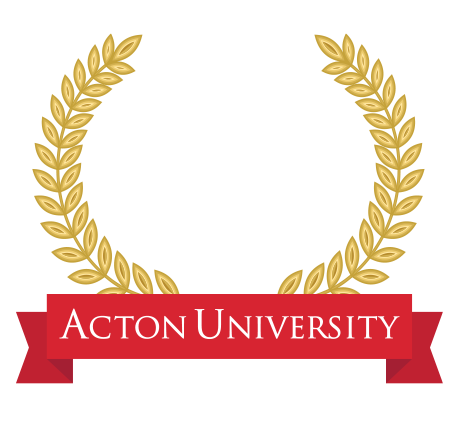I recently visited a friend of mine in Tuscany, an American artist named Shelly Goldstein. Shelly paints impressionist landscapes of the Tuscan countryside, with plenty of poppies, olive groves, herds of oxen, orchards, and usually the remains of an ancient torre, or an isolated chapel already centuries old when Columbus was a boy in Genoa, or off in the distance a typical little Tuscan town perched on a hilltop. Shelly paints in other parts of the world as well--Africa, Hawaii, New England, and the American Midwest--but I have never found his portrayal of those parts of the world as appealing as his depiction of the Tuscan countryside. During a recent visit, Shelly explained to me what he thinks I must find appealing in his Italian work; he said that what I see in his Tuscan landscapes is the hand of man who has worked upon the divine creation. That hand, which has developed the environment, is absent in most of his work in Africa, Hawaii, and even in his New England landscapes, all depictions of primitive, untamed nature.
As the hand of God formed all from nothing, He has entrusted His creation to the hand of man to do something with it. This is the purpose of creation: that man develop what God created. That is what I see and admire in the Tuscan orchards, vineyards, olive groves, and the herds of cattle and oxen; they are planted and led by human hands. They have not lain fallow; human stewardship is evident in their development. Even the wild poppies spring up in the midst of human order. Here we see man and nature in harmony as God intended.
The Tuscany of Shelly Goldstein's paintings is not at all far-removed from the Umbria of Saint Francis of Assisi, embraced today as the patron of most environmental and ecological movements, but what is the relation of man to nature in the thought of Saint Francis and in Shelly's art? The oxen portrayed are not in the preserve of some peta commune; rather, they are in the employ of farmers. In fact, Shelly portrays some employed by Franciscan friars in the tilling of their fields. In other words, work animals legitimately make possible the livelihood of farmers, including those Franciscans whose simplicity of life demands that they be self-supporting and develop the environment for their use and livelihood, as intended by the providential hand of God.
This true stewardship of creation, as admirably embraced by the Franciscan friars and depicted by Shelly Goldstein, entails the responsible use of the gifts of creation. A good steward does not coddle the resources entrusted to him and let them lie fallow and undeveloped. Rather, he uses them, develops them and, most appropriately, attempts to the best of his ability to realize their increase so that he may enjoy his livelihood and provide stewardship for the good of his family and other dependents.
In the area of business, for example, the employees are dependent upon the stewardship of their employer who has invested his capital so they may be engaged to the mutual good of both the employer and the employees in the enterprise of realizing their livelihood--impossible were there not good and responsible stewardship. A profit from stewardship is clearly shown in Scripture as an appropriate good as Christ commends the “good and faithful servant” for stewardship that realizes a profit in contrast to those “faithless” ones who have buried their treasure or have merely returned the original resources with no increase.
Responsible Stewardship
In Free Market Environmentalism, Terry Anderson and Donald Leal give some excellent examples of responsible stewardship. The International Paper Company, for example, employs specialists to oversee wildlife preservation and development on its lands, including the sixteen-hundred-acre Southlands Experiment Forest, outside Bainbridge, Georgia. Here ipc researchers develop forest management practices that enhance wildlife populations as well as corporate profits. The habitat for white-tailed deer, turkeys, rabbits, and quail is improved by controlled burning and tree-cutting practices that provide needed coverage and plenty of forage for wildlife, a greater benefit than if they lived in the wild. This stands in stark contrast to the abusive hand of man in the deforestation of northern Michigan a century ago, when loggers were concerned solely with their immediate profit, with no thought to the needed replenishment of those resources. Today's responsible stewards now enjoy both financial profits and the satisfaction of contributing to environmental preservation and enhancement.
In Nebraska, Sandhills Outfitters, Inc., offered a profitable alternative to ranchers who were in danger of losing their ranches because of the drastic decline in cattle prices. In 1987, they leased hunting rights to more than one thousand acres of private ranches, which provide a habitat for waterfowl, pheasant, sharp-tailed grouse, and prairie chicken. Families are able to maintain ownership of property that has been passed down over generations--the ownership of which was threatened by the previous underuse--at a still greater profit than previously realized through tax-supported government subsidies. All the while the environment is both developed and protected, with wildlife allowed to flourish on a preserve considerably more supportive than if they were left to predators in the wild.
North Maine Woods, Inc., was formed to offset problems from recreational use of land, such as soil erosion, overcrowding, littering, and the constant threat of forest fires. Registration fees and camping permits (ranging from two dollars per day to seventeen dollars for a whole season permit) generated revenue sufficient for the construction and improvement of campsites, a trash collection system, and public education on the environment. Clearly, the efforts here to make the environment more accessible at rates affordable to everyone, while protecting the ecosystem, are more successful than the much touted but tax-subsidized, efforts by the Department of the Interior and the National Park system.
As Anderson and Leal observe: “These examples suggest that it is not a lack of entrepreneurship that is preventing the private sector from producing more outdoor recreational and environmental amenities. As these goods rise in value, entrepreneurs will make efforts to capitalize on profit opportunities by establishing property rights. In many cases, however, government interferes with the private sector's potential by distorting markets and erecting institutions that make it prohibitively costly to establish private property rights to natural resources.”
Man, Creation's Greatest Resource
Nothing could be further removed from the faith of Judaism and Christianity, that faith of Saint Francis of Assisi, than the New Age worship of the environment. In the Judeo-Christian tradition that spans nearly four millennia, Saint Francis rightly stands above all other religious thinkers for his high regard and love for the environment, but he acknowledges that nature is no more than the gift of the Creator, given for human domination, development, and stewardship. God the Creator is alone deserving of worship. Like all Christians, Saint Francis knows that of all creation only humanity has been ennobled by the Incarnation; it was the Father's will for our salvation that his Son should be one of us, a human being.
For a single human being to starve or to lack the means of livelihood because of deference shown to any other created being, animal, or plant, is a denial of the dignity that humanity alone enjoys, that dignity that Saint Francis recognizes to be uniquely the highest in all the created order. Many environmentalists will present the depletion of the Amazon rain forests as an argument for creating nature preserves to be kept free of all “unnatural” human intrusion. This, however, is nothing more than a “straw man” argument, for they refuse to acknowledge that nature has, in fact, over millennia depleted these forests to a far greater degree than has the human use and development of these resources; this is the natural order of things.
Likewise, the systematic replenishment of these resources through responsible human stewardship has resulted in a far richer and balanced ecosystem. Roberto Calmanowtiz, the president of iveco, the biggest producer of cartons in Brazil and one of the largest in the world, is fully conscious of his responsibility to replenish the natural resources from which his profitable product is derived, while making possible a livelihood for hundreds who would otherwise be reduced to certain poverty in the barrios.
It is not “Earth in the Balance” but unbalanced reasoning that finds the most common expression in the ecological and environmental movement. As advanced by environmentalists, the refusal to develop a resource such as the rain forest would tragically result in the loss of employment for hundreds of thousands of workers. The workers are the descendants of the aboriginal workers of that land and can rightly lay claim to making their livelihood from that land, made possible only by the investment of others' capital. Lacking this, they in turn would be unable to provide a livelihood for themselves and their families, resulting in poverty so great that the family itself is threatened as the poor worker is forced to consider contraception or abortion as his only alternative to bringing a child into this life of poverty. Thus, the value put on the environment is made at the expense of human life itself.
The natural replenishment of resources looks for its mandate to a beneficent Creator. The most valuable resource in all creation, of course, remains the human person, who alone of all creation has the potential for renewing resources. Sadly, this fact is lost sight of by those who promote the destruction of human life in the womb, thereby diminishing the potential for renewed natural resources. With the loss of human life through abortion, there is in economic terms also the loss of the most valuable natural resource, the one that can alone replenish other resources.
The Gift of Work
Not only does this extreme sensitivity for environmental matters endanger human life and jeopardize human livelihood, but it denies the human person his dignity as advanced with consistency in the Judeo-Christian ethic. Work of itself seems to be part of the original divine plan; otherwise, God would not have charged man with domination over creation. That requires and presumes work on the part of man. It is only with his Fall that man brings upon himself the “sweat of the brow” as a human consequence of the divine gift of work. Work is not a punishment; the sweat is. As a worker, man has an opus to perform; as such, he can be said to be a cooperator with God, who as Creator of the opus that is the universe, must be the archetypal Worker.
Pope John Paul II put this perfectly in his Address to Workers on March 19, 1994, the feast of Saint Joseph the Worker:
“The most important product of work is man himself. Through his own activity, man forms himself as he discovers his own abilities and puts them to the test. At the same time, he gives himself to others and to society as a whole. Thus he establishes his own humanity through work, and becomes in a certain sense a gift for others, totally fulfilling himself.”
As the Pope knows too well from his own experience of totalitarian regimes, work can be dehumanizing, so he is concerned to add:
“Work should be carried out by man for man. Only then does it correspond to the proper order. Otherwise the Creator's plan is foiled and destroyed.”
Man rising to the fullness of his humanity exercises those original gifts in the garden: the human mind, each other, and nature, exercising rightful dominion over these of which the Creator has said: Omnia dabo vobis. In his responsible stewardship of nature, man enjoys his God-given dignity.






